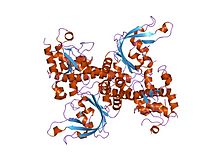EcoRII
表示

EcoRII (えこあーるつー)とは、Escherichia coliで見られる制限修飾系(RM)の制限酵素(REase)である。その分子量は45.2 kDaであり、402残基のアミノ酸で構成されている[1]。
活性型
[編集]EcoRIIは真正細菌のタイプIIE [2] REaseである。疑似回文構造のDNA 認識配列 5' - CC W GG - 3' (W = AまたはT )の2個[3]または3個 [4] (このうち1個は実際に標的を切断し、残りはアロステリックアクチベーターとして機能する)と相互作用する。 EcoRIIは、粘着末端を生成する標的DNA配列CCWGGを切断する[5]。
切断様式の図式
[編集]| 認識部位 | 切断結果 |
5 'NN CCWGG NN 3 'NN GGWCC NN |
5 'NN CCWGG NN 3 'NN GGWCC NN |
構造
[編集]| EcoRIIのN末端ドメイン | |||||||||
|---|---|---|---|---|---|---|---|---|---|
 制限酵素EcoRIIの突然変異体r88aの結晶構造 | |||||||||
| 識別子 | |||||||||
| 略号 | EcoRII-N | ||||||||
| Pfam | PF09217 | ||||||||
| Pfam clan | CL0405 | ||||||||
| InterPro | IPR015300 | ||||||||
| SCOP | 1na6 | ||||||||
| SUPERFAMILY | 1na6 | ||||||||
| |||||||||
| EcoRIIのC末端ドメイン | |||||||||
|---|---|---|---|---|---|---|---|---|---|
 制限酵素EcoRIIの突然変異体r88aの結晶構造 | |||||||||
| 識別子 | |||||||||
| 略号 | EcoRII-C | ||||||||
| Pfam | PF09019 | ||||||||
| Pfam clan | CL0236 | ||||||||
| InterPro | IPR015109 | ||||||||
| |||||||||
EcoRIIの構造変異体 R88A( PDB: 1NA6 )のアポ状態の結晶構造 [6] は、2.1Åの分解能で解明されている。EcoRIIの単量体は、ヒンジループを介して結合されたN末端及びC末端ドメインで構成されている。
エフェクター結合ドメイン
[編集]N末端のエフェクター結合ドメインは、顕著な裂溝を有する典型的なDNA結合性偽バレルフォールド(SCOP 101936)を持つ。構造から、進化的に以下に関連していることが明らかになっている。
- B3 DNA結合ドメイン (SCOP 117343):高等植物における転写因子( PDB: 1WID )の構成ドメイン [7]
- 制限酵素BfiIのC末端ドメイン [8] (PDB: 2C1L ) [9]
触媒ドメイン
[編集]C末端触媒ドメインは、典型的な制限酵素様フォールド( SCOP 52979 )を持ち[10]、30を超える巨大な制限酵素スーパーファミリー( SCOP 52980 )の構成タンパク質の一つである。
外部リンク
[編集]- 制限酵素データベースREBASE
脚注
[編集]- ^ Richard J. Roberts. “EcoRII”. REBASE - The Restriction Enzyme Database. 2008年3月23日閲覧。
- ^ “A nomenclature for restriction enzymes, DNA methyltransferases, homing endonucleases and their genes”. Nucleic Acids Res. 31 (7): 1805–12. (2003). doi:10.1093/nar/gkg274. PMC 152790. PMID 12654995. PDF
- ^ “Imaging DNA loops induced by restriction endonuclease EcoRII. A single amino acid substitution uncouples target recognition from cooperative DNA interaction and cleavage”. J. Biol. Chem. 275 (39): 30631–7. (2000). doi:10.1074/jbc.M003904200. PMID 10903314.PDF
- ^ “Direct visualization of the EcoRII-DNA triple synaptic complex by atomic force microscopy”. Biochemistry 46 (39): 11128–36. (2007). doi:10.1021/bi701123u. PMID 17845057.
- ^ Griffiths, Anthony J. F. (1999). An Introduction to genetic analysis. San Francisco: W.H. Freeman. ISBN 978-0-7167-3520-5
- ^ “Crystal structure of type IIE restriction endonuclease EcoRII reveals an autoinhibition mechanism by a novel effector-binding fold”. J. Mol. Biol. 335 (1): 307–19. (2004). doi:10.1016/j.jmb.2003.10.030. PMID 14659759.
- ^ “Solution structure of the B3 DNA binding domain of the Arabidopsis cold-responsive transcription factor RAV1”. Plant Cell 16 (12): 3448–59. (2004). doi:10.1105/tpc.104.026112. PMC 535885. PMID 15548737.PDF
- ^ Richard J. Roberts. “BfiI”. REBASE - The Restriction Enzyme Database. 2008年3月23日閲覧。
- ^ “Structure of the metal-independent restriction enzyme BfiI reveals fusion of a specific DNA-binding domain with a nonspecific nuclease”. Proc. Natl. Acad. Sci. U.S.A. 102 (44): 15797–802. (2005). doi:10.1073/pnas.0507949102. PMC 1266039. PMID 16247004. PDF
- ^ “Topology of Type II REases revisited; structural classes and the common conserved core”. Nucleic Acids Research 35 (7): 2227–37. (2007). doi:10.1093/nar/gkm045. PMC 1874628. PMID 17369272.
